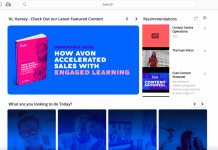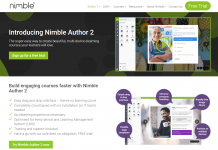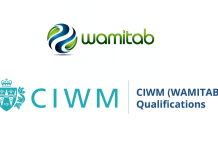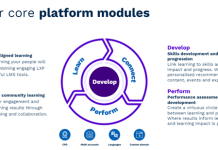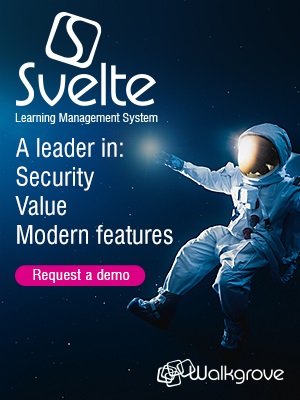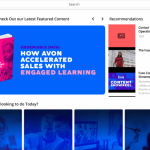Here we offer advice to US vendors, with 6 Things You Must Know to Market Your LMS in Europe – you may well need to change your approach!
My first two years of marketing in Europe were spent mostly beating my head against a wall. I knew it would be hard, and different from marketing to US buyers, so I went in with an open mind and tried to not assume anything. But it was still a big shock how different it was.

Several years later, I can say that I know what I’m doing now, but I’m still not 100% there. I still have plenty to learn, and that should always be the case. That’s the fun part of marketing. It’s more of an art than a science.
So, to save you the pain and the heartache, here are six major differences between B2B marketing in Europe versus the US. Disclaimer: This is mostly seen through my LMS-marketing lens, so this may not apply to everyone trying to market B2B software in Europe.
1. In Europe, it’s best to set aside e-mail marketing
This was the biggest shock for me. I knew e-mail marketing wasn’t as effective in Europe as the US, but I didn’t know it was almost a complete waste of time and could be a big negative. There are several reasons for this, but the biggest are the laws in Europe. They are much more stringent than the laws in the US, which basically say, “don’t overdo it” and then maybe slap you on the hand if you overdo it.
In addition to that, most of the people in Europe simply despise unsolicited e-mail. They don’t appreciate it and your abuse of email can be a real brand-killer.
In the US, e-mail is an essential piece of almost every marketer’s playbook. It’s safe to say that most US marketers have become too dependent on e-mail marketing.
And that’s not all. Coming soon is GDPR. Have your heard of that? If not, it’s time to get familiar with it, because it’s a game-changer for marketing in Europe. And before too long, I expect a version of it will creep over the Atlantic Ocean into the US market and change marketing as we know it.
In short, GDPR (General Data Protection Regulation) is the European Union’s very serious effort at protecting the digital privacy of their citizens. Any company doing business with EU citizens, including those outside of the EU, will be required to protect that data like they never have before. To sum it up for marketers: Stay away from purchased email lists. Here’s a good overview of GDPR, which starts May 25, 2018: http://www.dummies.com/education/politics-government/general-data-protections-regulation-gdpr/
The solution: If you must send emails, go through 3rd parties who have opt-in lists and comply with GDPR.
2. You have to speak the language, and that language is never American English
This is common sense, so it’s probably not a big surprise to you. But there are some nuances. First, France and Germany are very large economies and English is definitely a second business language. So, if you’re targeting one of these two countries, you must write in their language and it has to be perfect.
Also, keep in mind that the difference between marketing to countries like England and France is vastly different. They’re only separated by 20 miles of water, but they are worlds apart in culture. By comparison, Canada and the US are remarkably similar. A better comparison would be Mexico and the US.
Adjusting to these differences will take a lot of effort, so you have to ask yourself this question: “How much do I really want it?” To be truly successful in Europe, you have to have a local presence. You are extremely limited if you try to do it from afar.
Think of it this way:
- If you treat Europe like the US, you will fail. We can all agree on that.
- If you customize your marketing to fit the European market, you will sell something and possibly do OK. Maybe.
- If you develop a local presence in all the European countries that you’re targeting and you customize your marketing (and language) for those countries, then you have a good chance of success.
Even if you’re targeting the UK, you need a local presence, and your English needs to be English-English, not American-English. The UK is also a very large economy, so it’s expected.
There are a number of countries where the language of business is English. First among those are the Scandinavian (Nordic) countries of Sweden, Denmark, Norway and Finland. Most business people in those countries speak fluent English and don’t get upset when a website or brochure is in English. However, you should avoid US accents on things like videos and webinars, unless it’s from a subject matter expert who speaks with authority.
The solution: Go local, and expect to spend a lot of your budget on language and localization.
3. Tone down the hype machine and do away with exclamation points!
The American culture prides itself of thinking big, taking big risks, and unfortunately, over-hyping products.
It’s so ingrained that if your competitor says their products are #1 in the market and you just make modest claims, then you appear to be boring and second rate. There are big exceptions to this, as some US companies have differentiated themselves by not shouting at the top of their lungs and developed their brands as honest, believable, and breaths of fresh air. However, it takes a huge amount of brand discipline and marketing to pull this off.
It’s a different story in Europe. While the US hype dial is up to 11, Europe is at around 7. There’s some hype, but almost unrecognizable by US standards.
The solution: Dial down the hyperbole and communicate truths, so you can establish the credibility that makes you believable and trustworthy.
4. If they like you, you’ll have a friend for life
Up until now, most of what I’ve talked about are things that make it harder for a marketer. This one is about making it easier.
To generalize, I will say that European companies are more loyal customers and long-term thinkers than US companies. When you sell an LMS to an American customer, there’s a good chance that 3-5 years later, they will replace you. This is especially true with some industries like software companies, who change their LMS at an incredibly frequent rate.
There are two main reasons why Europeans customers are more loyal. The first is that they’re not fond of change. Second is they value long term relationships. So if you get in, you’re golden, as long as you don’t screw it up. On the flipside, it takes a long time and a lot of patience to develop that trust.
The solution: Think very long term about Europe and invest in it. If you do, it will pay off long term.
5. Brace yourself for the shockingly long sales cycles
You and I think it’s crazy for a US buyer to take six months to a year to pick a new learning system. Get ready for a whole new concept of time in Europe. It’s not out of the ordinary to take two year or longer to switch to a new system. Some of this has to do with laws in Europe, but a lot of it has to do with the culture in many countries.
But, on the bright side, once you’re in, you’re in.
The solution: Again, think long term. Patience.
6. They need to talk to a person
In the US, we’re very comfortable buying things without a face-to-face meeting with a salesperson. A lot of very large learning system deals were consummated over the phone, with web conferencing and through e-mail. Not a single handshake, two-hour lunch or round of golf. I’m not sure why this is. I suspect it’s because Americans are usually in a hurry and there is more inherent trust in vendors.
But in Europe, your salespeople will make or break you. Marketing is much more about supporting salespeople, who are leading the way. Europeans want a relationship with a vendor. This goes back to the importance of thinking long term. They just don’t want to get stuck with a company that they don’t like or don’t trust. Many face-to-face meetings are required.
But you know this can do terrible things to driving up your cost of sale. The travel costs are enormous and so is sales compensation. Comparing it to the US, I think sales and marketing costs are 50-50, compared to 70-30 in Europe.
The solution: Start investing now in salespeople and offices to put them in.
Those are my top 6 differences. In my next blog, I plan to go deep into what it takes for a European software vendor to get a foothold in the US. I can go out on a limb to say that this is even harder than it is for an American vendor trying to get into Europe. There are a lot of good reasons for this, but we’ll talk about it later.
For now, let me know what you think is missing from the list above. I’m still learning. Hope you are too.
Gordon L Johnson has been a marketing leader in the corporate L&D industry for over twenty years with the last ten years focused on learning technology, mostly in the US. Along the way, he’s discovered what works – and what doesn’t. More info at gordonljohnson.com.


